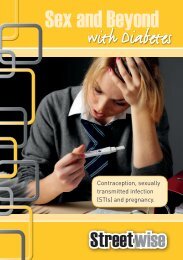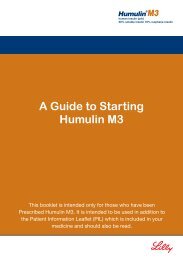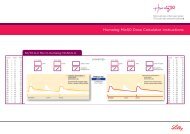A Guide to Starting Humulin M3
A Guide to Starting Humulin M3
A Guide to Starting Humulin M3
- No tags were found...
Create successful ePaper yourself
Turn your PDF publications into a flip-book with our unique Google optimized e-Paper software.
Contents• What should I have from the pharmacist?• Why have I been given this booklet?• What is <strong>Humulin</strong> <strong>M3</strong> and how does it work?• When do I take <strong>Humulin</strong> <strong>M3</strong>?• Who decides how much <strong>Humulin</strong> <strong>M3</strong> I need?• When do I check my blood glucose levels?• Instruction for self adjustment of my insulin• How do I inject my <strong>Humulin</strong> <strong>M3</strong>?• What if I forget an injection?• What is a hypo and why does it happen?• How do I deal with hypos?• What should I do if I feel unwell?
Why have I been given this booklet?You have been prescribed <strong>Humulin</strong> <strong>M3</strong> (your insulin),<strong>to</strong> help you manage your diabetes.The aim of this booklet is <strong>to</strong> allow you <strong>to</strong> learn moreabout your insulin and help you make the rightdecisions about adjusting your insulin, and takingcontrol of your diabetes.It is intended <strong>to</strong> be used in addition <strong>to</strong> the PatientInformation Leaflet provided with your medicine.
What is <strong>Humulin</strong> <strong>M3</strong> & how does it work?<strong>Humulin</strong> <strong>M3</strong> is made from a combination of two typesof insulin:• 30% Soluble Insulin (short acting)• 70% Isophane Insulin (intermediate acting)Putting <strong>to</strong>gether a short acting insulin and anintermediate acting insulin produces a quick risein insulin activity after injection, which graduallysubsides over time.This is how the <strong>Humulin</strong> <strong>M3</strong> works over a 24 hour period.24 hour action profileBreakfastInjectionLunchEveningInjectionapprox 30 minbefore breakfastapprox 30 minsbefore mealTheoretical representation of <strong>Humulin</strong> <strong>M3</strong> insulin activity profiletwice per dayExpected insulin production during the day in people without diabetesTime of injection - approx 30 minutes before meal
When do I take <strong>Humulin</strong> <strong>M3</strong>?This insulin should usually be taken about 30 minutesbefore breakfast and about 30 minutes before yourevening meal.You may be advised <strong>to</strong> take it more or less frequently;this will be decided between you and your healthcareprofessional.How much will I need?Please complete:approx. 30 minsbefore breakfastapprox. 30 minsbefore eveningmealDoseThis is your starting dose and may increase.Your dose may need <strong>to</strong> change based on your bloodglucose readings.
Who decides how much<strong>Humulin</strong> <strong>M3</strong> I will need?Your insulin dose will be adjusted by yourself and/oryour healthcare professional according <strong>to</strong> the bloodglucose tests you do.Do not worry if it takes a while before you reachyour target blood glucose levels and you need moreinsulin. Each person is different and what is importantis that it is the right amount for you.Why do I need <strong>to</strong> test my blood glucose levels?It is important that you are aware of your own bloodglucose levels in order for you <strong>to</strong> take the appropriateaction, for example, adjusting your insulin dose.There are a number of reasons why you may need <strong>to</strong>adjust your insulin dose, including:• High blood glucose levels (hyperglycaemia)• Low blood glucose levels (hypoglycaemia)• Stress/illness
When do I check myblood glucose levels?To test the effect of your insulin, the recommendedblood glucose tests are pre-meals and pre-bed.Your healthcare professional will discuss with youhow often <strong>to</strong> test.What should your blood glucose levels be?Please complete:Your pre-breakfast............... mmol/LYour pre-lunchYour pre-evening mealYour pre-bed............... mmol/L............... mmol/L............... mmol/LIt may take a while <strong>to</strong> achieve these levels and youmay require an increase of your insulin.Do I need <strong>to</strong> adjust my insulin and how do I do it?You might not need <strong>to</strong> adjust your insulin. If youdo need <strong>to</strong> adjust your insulin your healthcareprofessional will talk you through the next few steps.You may feel apprehensive at first, but it is importantthat you take control <strong>to</strong> make it work for you.
Instruction for self-adjustmen<strong>to</strong>f my insulinWhen testing your blood glucose, if you haveconsistently high readings for more than three daysat any testing point, then you will need <strong>to</strong> adjustyour insulin.Your healthcare professional will explain <strong>to</strong> you how<strong>to</strong> adjust your insulin and will complete the followingtable for you needs.<strong>Humulin</strong><strong>M3</strong> twicedailyBeforeBreakfastBefore LunchBeforeEveningMealBefore BedAbove Below Above Below Above Below Above BelowAdjustdoseAdjust EveningdoseAdjust Morning doseAdjust EveningdoseDose reduction is recommended if any results areconsistently less than 4 mmol/L at any time.
How do I inject my <strong>Humulin</strong> <strong>M3</strong>?Your healthcare professional will explain how <strong>to</strong>inject your insulin. Injection is usually via approvedpen devices or insulin syringe.Where do I inject?Your insulin can be injected in the places shownbelow. The site of the injection should be rotatedwithin the chosen area <strong>to</strong> prevent complicationsdeveloping at your injection site and aid absorption.Check with your healthcare professional for suitabilityof injection sites.
Preparing your injectionIt is important that before you inject your insulin yourotate it between the palms of the hands ten times andinvert it through 180° ten times immediately before use.This is <strong>to</strong> ensure the insulin is mixed properly. It shouldappear uniformly cloudy or milky.The image above is a KwikPen, if you have beenprescribed <strong>Humulin</strong> <strong>M3</strong> in a cartridge you should loadthe cartridge in<strong>to</strong> the pen device and then mix similarly<strong>to</strong> that shown above.
What if I forget an injection?Forgetting your insulin is rarely an emergencysituation. Seek advice from your diabetes team.The advice will vary depending on when you haverealised you have forgotten <strong>to</strong> take your insulinWhat if I cannot remember if I had my insulin?If you are in any doubt, do not take again. In bothcases your blood glucose may run a little higher afterthe injection you have forgotten. Do not worry.It is very important that youknow the name of your Pen device,your insulin and the nameof your blood glucose meterMy insulin is:My pen is:My blood glucose meter is:
What is a hypo and why does it happen?A blood glucose reading of 4 mmol/L and under ishypoglyceamia (a hypo). A hypo occurs when bloodglucose falls <strong>to</strong>o low. People feel different thingswhen a hypo is starting, you may also find some ofyour hypos feel different from others.A hypo can happen for a number of reasons;• If you’ve missed a meal or had one later than usual• If you’ve not had enough food or eaten less foodthan normal• If you’ve had more insulin than necessary• If you’ve been more active than usual• If you’ve been drinking alcohol• If you’ve experienced extremes in temperature,either hot or coldIf your diabetes is well controlled occasional hyposare a normal part of life for people with diabetes, butthey shouldn’t take over your life. If you are havingfrequent hypos, speak with your diabetes team.
Hypos begin quickly, but there are usually warningsigns. Symp<strong>to</strong>ms can vary from person <strong>to</strong> person,but may include the following:• Sweating• Thumping heart• Looking pale• Weakness or tiredness• Pins and needles sensation• Dizziness/ feeling tipsy, drunk• Disturbed vision• Mild confusion• Slurred speech• Hunger• Aggression or altered behaviour• HeadacheIf hypoglycaemia isn’t corrected it can lead <strong>to</strong> moreserious conditions such as loss of consciousness.
How do I deal with hypos?If you experience a hypo, you should deal with it bytaking 15-20g of quick acting carbohydrate such as:• 5 - 7 Dextrosol ® tablets or,• 90-120 ml of original Lucozade ® or,• 100-200 ml of pure fruit juice such as orange juiceYour healthcare professional may also advise you ofquick acting carbohydrate such as:It is advisable <strong>to</strong> re-check your blood glucose level <strong>to</strong>ensure your blood glucose levels are rising.
If you are not about <strong>to</strong> eat a meal, ensure you eat10-20 grams of slow acting carbohydrate, <strong>to</strong> maintainyour blood glucose levels until you next eat.This can be:• half a sandwich• fruit• a small bowl of cereal• biscuits and milkYour healthcare professional may also advise you ofslow acting carbohydrate such as:The exact quantity will vary from person <strong>to</strong> personRemember <strong>to</strong> carry your identity card and glucosetablets with you in case of an emergency.If you have regular hypos consider adjusting yourinsulin and/or contacting your nurse or doc<strong>to</strong>r.
What should I do if I feel unwell?A number of common illnesses can cause your bloodglucose <strong>to</strong> rise. When you are unwell you may notwant <strong>to</strong> eat or take your insulin treatment as normal,but it is important <strong>to</strong> follow these basic rules:1. Keep on taking your insulinHowever ill you feel and however little food you areeating, you may still need insulin. Sometimes in thesecircumstances you need more than your usual dose.Ask your healthcare professional for specific adviceon what action <strong>to</strong> take when you are ill.2. Moni<strong>to</strong>r your blood glucoseMoni<strong>to</strong>r your blood glucose. Test at least 4 timesdaily as your blood glucose levels will indicatewhether you require extra insulin doses.3. Take carbohydrates in liquid formTake unsweetened fluids if your blood glucose ishigh. If you still do not feel like eating as your bloodglucose returns <strong>to</strong> normal then substitute food withsweetened fruit juices or drinks that contain glucose.
Notes Page
Notes Page
Side effects should be reported.This includes any possible side effects not listed inthe package leaflet. If you experience side effects talk<strong>to</strong> your doc<strong>to</strong>r or other healthcare professional.Any side effects from your medication can be reported atwww.mhra.gov.uk/yellowcard.Side effects and product complaints can also bereported <strong>to</strong> Lilly: please call Lilly UK on 01256 315 000.By reporting side effects you can help provide moreinformation on the safety of medicines.Eli Lilly & Company LtdPriestley RoadBasings<strong>to</strong>keRG24 9NL01256 315 000www.lillydiabetes.co.uk/patientsThis booklet has been developed with the Diabetes Specialist Nurses in Sheffield andMid-Yorks NHS Trust and funded by Lilly as a service <strong>to</strong> patient care.The booklet has been reviewed for medical accuracy and printed by Lilly.UKHML00057c(1) March 2014


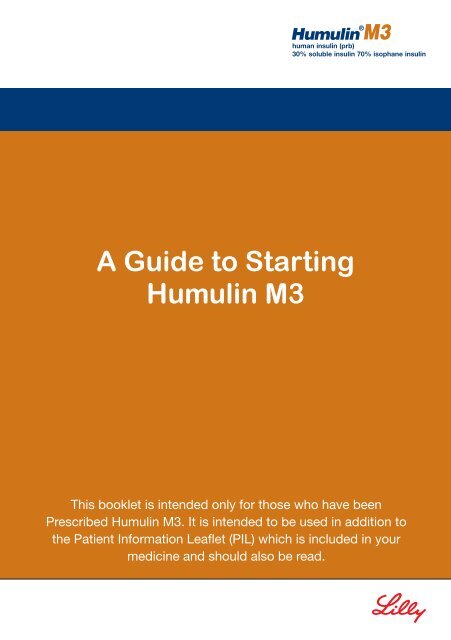




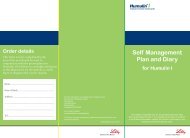


![Humalog Mix50 (50% insulin lispro [rDNA origin] injection ... - LillyPro](https://img.yumpu.com/44269187/1/184x260/humalog-mix50-50-insulin-lispro-rdna-origin-injection-lillypro.jpg?quality=85)

![Humalog Mix25 (25% insulin lispro [rDNA origin] injection 75 ...](https://img.yumpu.com/35487335/1/184x260/humalog-mix25-25-insulin-lispro-rdna-origin-injection-75-.jpg?quality=85)
